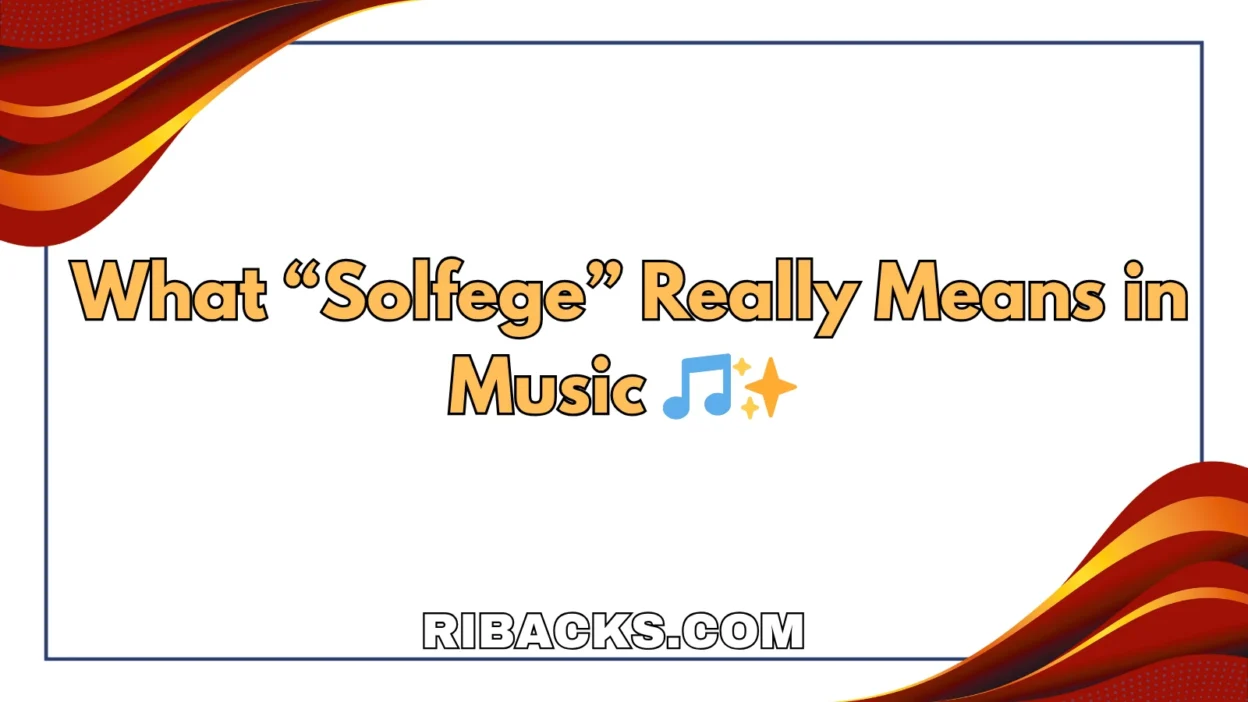If you’ve ever watched a singing class, choir rehearsal, or even a TikTok vocal tutorial, you might’ve heard people saying things like “do, re, mi, fa, so…” and wondered what on earth they’re doing.
I remember hearing it for the first time and thinking it sounded like a magical spell rather than a music tool. But no — it’s something much more useful.
Quick Answer:
Solfege (sometimes spelled solfège) is a music training system that uses syllables like do, re, mi, fa, sol, la, ti to teach pitch, melody, and ear training.
🧠 What Does Solfege Mean?
Solfege is a method used in music education to help singers and musicians learn pitch, scales, and melodies using specific syllables:
Do – Re – Mi – Fa – Sol – La – Ti – Do
It helps you identify how each note in a scale feels and sounds.
Example:
A music teacher might say: “Sing the scale in solfege: do–re–mi–fa–sol–la–ti–do.”
In short:
Solfege = Do–Re–Mi system = A method to learn musical pitch.
📱 Where Is Solfege Commonly Used?
Solfege shows up in many music-learning situations:
🎶 Music Education
- Choir practice
- Vocal warm-ups
- School music classes
- Ear-training lessons
📱 Online / Social Media
- TikTok singing tutorials
- YouTube vocal lessons
- Instagram reels from vocal coaches
🎤 Casual Practice
- Singers training their ear
- Musicians learning scales
- Beginners learning to match pitch
➡️ Note: Solfege is not used in texting slang — it’s purely a music term.
💬 Examples of Solfege in Real Conversations
These are realistic, everyday-style conversations involving the word solfege:
1.
A: “Why do singers use do re mi?”
B: “That’s solfege — it helps practice pitch.”
2.
A: “Can you teach me the solfege scale?”
B: “Sure! It starts with do re mi.”
3.
A: “I suck at matching notes.”
B: “Try solfege, it really helps.”
4.
A: “My music teacher keeps making us do solfege warm-ups.”
B: “Lol same, but they actually work.”
5.
A: “Is solfege only for singing?”
B: “Mostly, but instrumentalists use it too.”
🕓 When to Use and When Not to Use Solfege
✅ Use Solfege When:
- Practicing singing
- Learning musical scales
- Improving ear training
- Doing choir or vocal warm-ups
- Teaching beginners how pitch works
❌ Don’t Use Solfege When:
- Sending texts unrelated to music
- Writing formal documents
- Referring to general sound or beats
- Talking about rhythm (solfege is only for pitch)
✔ Comparison Table
| Context | Example Phrase | Why It Works |
|---|---|---|
| Music Class | “Let’s sing this in solfege.” | Shows pitch learning |
| Choir Rehearsal | “Start from ‘mi’ and go to ‘sol.’” | Uses solfege syllables |
| Vocal Practice | “Try the do-re-mi scale slowly.” | Helps train ear |
| Formal Writing | “Practice the major scale.” | Clear & professional |
🔄 Similar Musical Terms or Alternatives
| Term | Meaning | When to Use |
|---|---|---|
| Scale | A sequence of musical notes | General music learning |
| Pitch | How high or low a note is | Ear training |
| Interval | Distance between two notes | Advanced music theory |
| Sight-singing | Reading music while singing | Choir & music classes |
| Vocal warm-up | Exercises to prepare the voice | Before singing |
❓ FAQs About Solfege
❓ What are the 7 solfege notes?
The seven main syllables are: Do, Re, Mi, Fa, Sol, La, Ti.
❓ Is it “Solfege” or “Solfège”?
Both are correct — solfège is the French spelling.
❓ Why do singers use solfege?
It helps train the ear, learn pitch, and understand melodies more easily.
❓ Is solfege only for beginners?
No — even professional singers use it for warm-ups and pitch training.
❓ What’s the difference between fixed do and movable do?
- Fixed Do: “Do” always means C
- Movable Do: “Do” changes based on the key
📝 Final Thoughts
Solfege is one of the most powerful tools in music learning — simple, memorable, and incredibly effective.
Whether you’re a total beginner or a seasoned singer, using do re mi makes understanding pitch and melody much easier.
It’s a universal language for musicians worldwide, helping people train their ears and master musical scales with confidence.



